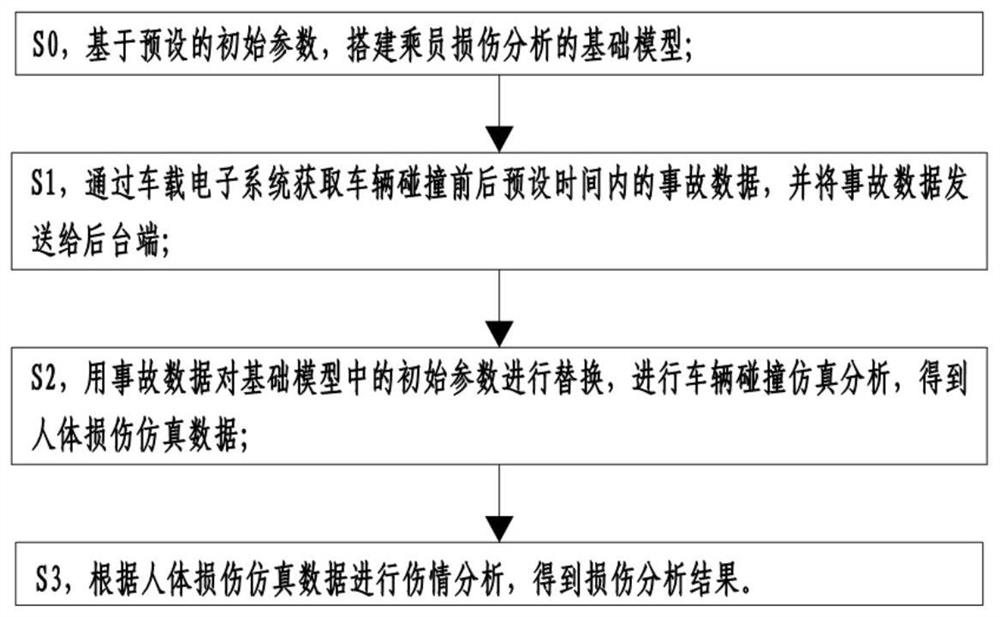In-vehicle personnel trauma risk prediction method for traffic accident rapid rescue
A technology for people in the car and traffic accidents, applied in the field of traffic accident rescue, can solve problems such as inconsistent injuries, missed injuries by the wounded, and the impact of the degree of injury, to achieve the effect of ensuring effectiveness, sufficiency, and accuracy
- Summary
- Abstract
- Description
- Claims
- Application Information
AI Technical Summary
Problems solved by technology
Method used
Image
Examples
Embodiment 1
[0041]It should be noted that the implementation of this method relies on the backend and the vehicle installed on the vehicle; in this embodiment, the backend is a server; the vehicle is used to collect and send accident data. Such as figure 1 As shown, the trauma risk prediction method for vehicle occupants used in the rapid rescue of traffic accidents includes:
[0042] S0, based on the preset initial parameters, build the basic model of occupant damage analysis. The input parameters of the basic model include vehicle basic data, dynamic boundary data, restraint system execution data and basic occupant data, and the output parameters include human injury simulation data. Specifically, when building the basic model, use the MADYMO software to parametrically edit the features of the simulation model to build a "crew cabin-crew-restraint system" modular simulation model. MADYMO (MAthematical DYnamic MOdel) multi-rigid body dynamics analysis software was originally completed i...
Embodiment 2
[0054] The difference from Embodiment 1 is that in S0 of this embodiment, a verification library is also set and stored in the background end, and the damage level range corresponding to each acceleration curve is stored in the verification library.
[0055] In S3, after the damage analysis result is obtained, the corresponding damage level range is matched according to the acceleration curve. If the damage level in the damage analysis result is not within the damage level range, a re-acquisition signal is sent to the on-board electronic system, and the on-board electronic system receives After re-collecting the signal, re-collect the accident data and send it to the backend.
[0056] If the damage level in the damage analysis result is not within the damage level range, it means that there is a problem in the analysis, for example, a slow acceleration curve has a very high severity damage level. Since the analysis at the backend is based on model analysis, the stability of th...
Embodiment 3
[0058] Different from Embodiment 1, in this embodiment, the acquisition device of the on-board electronic system includes a pressure sensor arranged on the seat and an infrared sensor under the seat; wherein, each seat has a plurality of pressure sensors , a plurality of pressure sensors are evenly arranged on the seat.
[0059] In S1, when obtaining the basic occupant data, if a seat is under pressure and the seat belt is not used, start the infrared sensor under the corresponding seat to analyze the number of legs of the occupant on the seat; if both feet are on the ground, record It is a normal sitting posture. If one foot is on the ground, it is recorded as cross-legged; if both feet are not on the ground, analyze the number and position of the corresponding seats. If there are three seats in the back row, it is recorded as sleeping; otherwise, analyze the Pressure data, if the pressure data is greater than the preset value, it will be recorded as cross-legged, if the pres...
PUM
 Login to View More
Login to View More Abstract
Description
Claims
Application Information
 Login to View More
Login to View More - R&D
- Intellectual Property
- Life Sciences
- Materials
- Tech Scout
- Unparalleled Data Quality
- Higher Quality Content
- 60% Fewer Hallucinations
Browse by: Latest US Patents, China's latest patents, Technical Efficacy Thesaurus, Application Domain, Technology Topic, Popular Technical Reports.
© 2025 PatSnap. All rights reserved.Legal|Privacy policy|Modern Slavery Act Transparency Statement|Sitemap|About US| Contact US: help@patsnap.com

